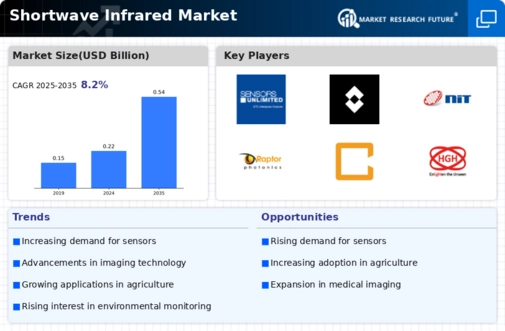Market Share
Shortwave Infrared Market Share Analysis
In the dynamic landscape of the Shortwave Infrared (SWIR) market, strategic positioning to secure a significant market share is a critical consideration for businesses. One primary strategy involves differentiation through technological innovation. Companies that invest in research and development to enhance the capabilities of SWIR sensors gain a competitive edge. By offering advanced features, improved sensitivity, and cost-effective solutions, these companies can attract a larger customer base and establish themselves as leaders in the market.
Price positioning is another pivotal strategy in the SWIR market. Some companies focus on providing cost-effective SWIR solutions without compromising on quality. This approach is particularly appealing to price-sensitive segments of the market, driving volume sales and market penetration. On the contrary, premium pricing strategies cater to customers seeking top-of-the-line SWIR technology with cutting-edge features. Striking the right balance between pricing and product features is crucial for companies aiming to capture a substantial market share.
Market segmentation is a strategy that involves targeting specific industries or applications within the SWIR market. By understanding the unique needs of different sectors such as healthcare, defense, manufacturing, and agriculture, companies can tailor their SWIR solutions to address specific challenges and requirements. This targeted approach allows businesses to establish themselves as specialists in particular niches, gaining market share in specialized segments.
Partnerships and collaborations also play a key role in market share positioning. Companies that form strategic alliances with other players in the SWIR ecosystem, such as sensor manufacturers, software developers, or end-users, can leverage collective strengths to offer comprehensive solutions. These partnerships enhance the overall value proposition and market presence, contributing to a more significant market share.
Geographical positioning is a strategy that takes into account the global distribution of market demand. Companies may focus on specific regions where the adoption of SWIR technology is expected to grow rapidly. Understanding regional preferences, regulatory environments, and market trends allows businesses to tailor their strategies to the unique dynamics of each geography. This targeted approach can lead to a more effective allocation of resources and a stronger market share in specific regions.
Brand positioning is crucial for establishing trust and recognition in the SWIR market. Companies that invest in building a strong brand image through marketing, communication, and customer engagement activities can differentiate themselves from competitors. A positive brand perception influences purchasing decisions, attracting customers and contributing to a higher market share. Consistent messaging, reliability, and customer satisfaction are key elements of successful brand positioning.
Responsive strategies that adapt to market trends and customer feedback are essential for maintaining and growing market share. Companies that actively monitor market dynamics, customer preferences, and emerging technologies can adjust their strategies in real-time. This agility allows businesses to stay ahead of the competition, capitalize on new opportunities, and address evolving customer needs effectively.











Leave a Comment